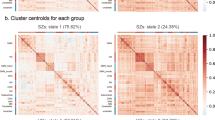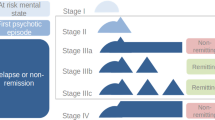Abstract
In this first cross-sectional MRI study in acute catatonia, we compared the resting state whole-brain, within-network and seed (left precentral gyrus)-to-voxel connectivity, as well as cortical surface complexity between a sample of patients in acute retarded catatonic state (n = 15) diagnosed as per DSM-5 criteria and a demographically matched healthy control sample (n = 15). The patients had comorbid Axis-I psychiatric disorders including schizophrenia spectrum disorders and psychotic mood disorders, but did not have diagnosable neurological disorders. Acute retarded catatonia was characterized by reduced resting state functional connectivity, most robustly within the sensorimotor network; diffuse region of interest (ROI)-ROI hyperconnectivity; and seed-to-voxel hyperconnectivity in the frontoparietal and cerebellar regions. The seed (left precentral gyrus)-to-voxel connectivity was positively correlated to the catatonia motor ratings. The ROI–ROI as well as seed-to-voxel functional hyperconnectivity were noted to be higher in lorazepam responders (n = 9) in comparison to the non-responders (n = 6). The overall Hedges’ g effect sizes for these analyses ranged between 0.82 and 3.53, indicating robustness of these results, while the average Dice coefficients from jackknife reliability analyses ranged between 0.6 and 1, indicating fair (inter-regional ROI–ROI connectivity) to perfect (within-sensorimotor network connectivity) reliability of the results. The catatonia sample showed reduced vertex-wise cortical complexity in the right insular cortex and contiguous areas. Thus, we have identified neuroimaging markers of the acute retarded catatonic state that may show an association with treatment response to benzodiazepines. We discuss how these novel findings have important translational implications for understanding the pathophysiology of catatonia as well as for the mechanistic understanding and prediction of treatment response to benzodiazepines.






Similar content being viewed by others
Availability of data and material
The data used in this study are available from the corresponding author, upon a reasonable request.
Code availability
SPM, CAT, and Conn functional connectivity toolboxes are freely available at their respective websites.
References
Fink M (2013) Rediscovering catatonia: the biography of a treatable syndrome. Acta Psychiatr Scand 127:1–47. https://doi.org/10.1111/acps.12038
Haroche A, Rogers J, Plaze M et al (2020) Brain imaging in catatonia: systematic review and directions for future research. Psychol Med 50:1585–1597. https://doi.org/10.1017/S0033291720001853
Walther S, Stegmayer K, Wilson JE et al (2019) Structure and neural mechanisms of catatonia. Lancet Psychiatry 6:610–619. https://doi.org/10.1016/S2215-0366(18)30474-7
Walther S, Schäppi L, Federspiel A et al (2017) Resting-state hyperperfusion of the supplementary motor area in catatonia. Schizophr Bull 43:972–981. https://doi.org/10.1093/schbul/sbw140
Hirjak D, Rashidi M, Kubera KM et al (2020) Multimodal magnetic resonance imaging data fusion reveals distinct patterns of abnormal brain structure and function in catatonia. Schizophr Bull 46:202–210. https://doi.org/10.1093/schbul/sbz042
Hirjak D, Kubera KM, Northoff G et al (2019) Cortical contributions to distinct symptom dimensions of catatonia. Schizophr Bull 45:1184–1194. https://doi.org/10.1093/schbul/sby192
Dean DJ, Woodward N, Walther S et al (2020) Cognitive motor impairments and brain structure in schizophrenia spectrum disorder patients with a history of catatonia. Schizophr Res 222:335–341. https://doi.org/10.1016/j.schres.2020.05.012
Yotter RA, Nenadic I, Ziegler G et al (2011) Local cortical surface complexity maps from spherical harmonic reconstructions. Neuroimage 56:961–973. https://doi.org/10.1016/j.neuroimage.2011.02.007
Narr KL, Bilder RM, Kim S et al (2004) Abnormal gyral complexity in first-episode schizophrenia. Biol Psychiat 55:859–867. https://doi.org/10.1016/j.biopsych.2003.12.027
Narr KL, Thompson PM, Sharma T et al (2001) Three-dimensional mapping of gyral shape and cortical surface asymmetries in schizophrenia: gender effects. AJP 158:244–255. https://doi.org/10.1176/appi.ajp.158.2.244
Collantoni E, Madan CR, Meneguzzo P et al (2020) Cortical complexity in anorexia nervosa: a fractal dimension analysis. J Clin Med 9:833. https://doi.org/10.3390/jcm9030833
King RD, Brown B, Hwang M et al (2010) Fractal dimension analysis of the cortical ribbon in mild Alzheimer’s disease. Neuroimage 53:471–479. https://doi.org/10.1016/j.neuroimage.2010.06.050
de Miras JR, Costumero V, Belloch V et al (2017) Complexity analysis of cortical surface detects changes in future Alzheimer’s disease converters. Hum Brain Mapp 38:5905–5918. https://doi.org/10.1002/hbm.23773
Hirjak D, Kubera KM, Wolf RC et al (2020) Going Back to Kahlbaum’s Psychomotor (and GABAergic) origins: is catatonia more than just a motor and dopaminergic syndrome? Schizophr Bull 46:272–285. https://doi.org/10.1093/schbul/sbz074
Rasmussen SA, Mazurek MF, Rosebush PI (2016) Catatonia: Our current understanding of its diagnosis, treatment and pathophysiology. World J Psychiatry 6:391–398. https://doi.org/10.5498/wjp.v6.i4.391
Suchandra HH, Reddi VSK, Aandi Subramaniyam B et al (2020) Revisiting lorazepam challenge test: clinical response with dose variations and utility for catatonia in a psychiatric emergency setting. Aust N Z J Psychiatry. https://doi.org/10.1177/0004867420968915
Sienaert P, Dhossche DM, Vancampfort D et al (2014) A clinical review of the treatment of catatonia. Front Psychiatry. https://doi.org/10.3389/fpsyt.2014.00181
Raveendranathan D, Narayanaswamy JC, Reddi SV (2012) Response rate of catatonia to electroconvulsive therapy and its clinical correlates. Eur Arch Psychiatry Clin Neurosci 262:425–430. https://doi.org/10.1007/s00406-011-0285-4
American Psychiatric Association (2013) Diagnostic and statistical manual of mental disorders: DSM-5TM, 5th edn. American Psychiatric Publishing Inc, Arlington. https://doi.org/10.1176/appi.books.9780890425596
Bush G, Fink M, Petrides G et al (1996) Catatonia. I. Rating scale and standardized examination. Acta Psychiatr Scand 93:129–136. https://doi.org/10.1111/j.1600-0447.1996.tb09814.x
Northoff G, Koch A, Wenke J et al (1999) Catatonia as a psychomotor syndrome: a rating scale and extrapyramidal motor symptoms. Mov Disord 14:404–416. https://doi.org/10.1002/1531-8257(199905)14:3%3c404::AID-MDS1004%3e3.0.CO;2-5
Bush G, Fink M, Petrides G et al (1996) Catatonia. II. Treatment with lorazepam and electroconvulsive therapy. Acta Psychiatr Scand 93:137–143. https://doi.org/10.1111/j.1600-0447.1996.tb09815.x
Fink M, Taylor MA (2003) Catatonia: a clinician’s guide to diagnosis and treatment. Cambridge University Press, Cambridge. https://doi.org/10.1017/CBO9780511543777
Li X, Morgan PS, Ashburner J et al (2016) The first step for neuroimaging data analysis: DICOM to NIfTI conversion. J Neurosci Methods 264:47–56. https://doi.org/10.1016/j.jneumeth.2016.03.001
Whitfield-Gabrieli S, Nieto-Castanon A (2012) Conn: a functional connectivity toolbox for correlated and anticorrelated brain networks. Brain Connect 2:125–141. https://doi.org/10.1089/brain.2012.0073
Gaser C, Dahnke R, Kurth K et al. A computational anatomy toolbox for the analysis of structural MRI data. NeuroImage (In review)
Ardekani BA (2018) A new approach to symmetric registration of longitudinal structural MRI of the human brain. bioRxiv. https://doi.org/10.1101/306811 (Published Online First)
Ardekani BA, Bachman AH (2009) Model-based automatic detection of the anterior and posterior commissures on MRI scans. Neuroimage 46:677–682. https://doi.org/10.1016/j.neuroimage.2009.02.030
Ardekani BA, Kershaw J, Braun M et al (1997) Automatic detection of the mid-sagittal plane in 3-D brain images. IEEE Trans Med Imaging 16:947–952. https://doi.org/10.1109/42.650892
Behzadi Y, Restom K, Liau J et al (2007) A component based noise correction method (CompCor) for BOLD and perfusion based fMRI. Neuroimage 37:90–101. https://doi.org/10.1016/j.neuroimage.2007.04.042
Smith SM, Nichols TE (2009) Threshold-free cluster enhancement: addressing problems of smoothing, threshold dependence and localisation in cluster inference. Neuroimage 44:83–98. https://doi.org/10.1016/j.neuroimage.2008.03.061
Glasser MF, Coalson TS, Robinson EC et al (2016) A multi-modal parcellation of human cerebral cortex. Nature 536:171–178. https://doi.org/10.1038/nature18933
Sui J, Pearlson G, Caprihan A et al (2011) Discriminating schizophrenia and bipolar disorder by fusing fMRI and DTI in a multimodal CCA + joint ICA model. Neuroimage 57:839–855. https://doi.org/10.1016/j.neuroimage.2011.05.055
Sui J, He H, Pearlson GD et al (2013) Three-way (N-way) fusion of brain imaging data based on mCCA+jICA and its application to discriminating schizophrenia. Neuroimage 66:119–132. https://doi.org/10.1016/j.neuroimage.2012.10.051
Zou Q-H, Zhu C-Z, Yang Y et al (2008) An improved approach to detection of amplitude of low-frequency fluctuation (ALFF) for resting-state fMRI: fractional ALFF. J Neurosci Methods 172:137–141. https://doi.org/10.1016/j.jneumeth.2008.04.012
Durlak JA (2009) How to select, calculate, and interpret effect sizes. J Pediatr Psychol 34:917–928. https://doi.org/10.1093/jpepsy/jsp004
Wilke M (2012) An iterative jackknife approach for assessing reliability and power of fMRI group analyses. PLoS ONE 7:e35578. https://doi.org/10.1371/journal.pone.0035578
Wasserthal J, Maier-Hein KH, Neher PF et al (2020) Multiparametric mapping of white matter microstructure in catatonia. Neuropsychopharmacol 45:1750–1757. https://doi.org/10.1038/s41386-020-0691-2
Northoff G, Steinke R, Czcervenka C et al (1999) Decreased density of GABA-A receptors in the left sensorimotor cortex in akinetic catatonia: investigation of in vivo benzodiazepine receptor binding. J Neurol Neurosurg Psychiatry 67:445–450. https://doi.org/10.1136/jnnp.67.4.445
Nasrallah FA, Singh KKD, Yeow LY et al (2017) GABAergic effect on resting-state functional connectivity: dynamics under pharmacological antagonism. Neuroimage 149:53–62. https://doi.org/10.1016/j.neuroimage.2017.01.040
Hillary FG, Roman CA, Venkatesan U et al (2015) Hyperconnectivity is a fundamental response to neurological disruption. Neuropsychology 29:59–75. https://doi.org/10.1037/neu0000110
Staba RJ (2012) Normal and pathologic high-frequency oscillations. In: Noebels J, Avoli M, Rogawski M (eds) Jasper’s basic mechanisms of the epilepsies. National Center for Biotechnology Information, Bethesda
Liu S, Parvizi J (2019) Cognitive refractory state caused by spontaneous epileptic high-frequency oscillations in the human brain. Sci Transl Med. https://doi.org/10.1126/scitranslmed.aax7830
Ungvari GS, Leung CM, Wong MK et al (1994) Benzodiazepines in the treatment of catatonic syndrome. Acta Psychiatr Scand 89:285–288. https://doi.org/10.1111/j.1600-0447.1994.tb01515.x
Yassa R, Iskandar H, Lalinec M et al (1990) Lorazepam as an adjunct in the treatment of catatonic states: an open clinical trial. J Clin Psychopharmacol 10:66–67
Cohen J (1988) Statistical power analysis for the behavioral sciences, 2nd edn. Routledge Academic, New York. https://doi.org/10.1016/C2013-0-10517-X
Sawilowsky S (2009) New effect size rules of thumb. J Mod Appl Stat Methods. https://doi.org/10.22237/jmasm/1257035100
Sienaert P, Rooseleer J, De Fruyt J (2011) Measuring catatonia: a systematic review of rating scales. J Affect Disord 135:1–9. https://doi.org/10.1016/j.jad.2011.02.012
van der Heijden FMMA, Tuinier S, Arts NJM et al (2005) Catatonia: disappeared or under-diagnosed? PSP 38:3–8. https://doi.org/10.1159/000083964
Stuivenga M, Morrens M (2014) Prevalence of the catatonic syndrome in an acute inpatient sample. Front Psych 5:174. https://doi.org/10.3389/fpsyt.2014.00174
Subramaniyam BA, Muliyala KP, Hari Hara S et al (2019) Prevalence of catatonic signs and symptoms in an acute psychiatric unit from a tertiary psychiatric center in India. Asian J Psychiatr 44:13–17. https://doi.org/10.1016/j.ajp.2019.07.003
Chumbley JR, Friston KJ (2009) False discovery rate revisited: FDR and topological inference using Gaussian random fields. Neuroimage 44:62–70. https://doi.org/10.1016/j.neuroimage.2008.05.021
Acknowledgements
We acknowledge the support from NIMHANS for carrying out this research as part of the M.D. dissertation of A.G. We thank Mr. Krishnendu Vyas for assistance with the data acquisition of healthy subjects.
Funding
P.P. acknowledges salary support from the Accelerator Program for Discovery in Brain Disorders using Stem Cells (ADBS) project, funded by the Department of Biotechnology, Government of India (BT/PR17316/MED/31/326/2015). No specific funding was received towards this work.
Author information
Authors and Affiliations
Contributions
The author contributions are based on Contributor Roles Taxonomy (CRediT) (https://casrai.org/credit/): PP: methodology, software, validation, formal analysis, data curation, writing—original draft, writing—review and editing, and visualization. AG: conceptualization, investigation, data curation, and writing—review and editing. VSKR: conceptualization, resources, writing—review and editing, and supervision. JS: conceptualization, investigation, resources, writing—review and editing, supervision, and project administration. JPJ: conceptualization, methodology, validation, resources, data curation, writing—original draft, writing—review and editing, visualization, supervision, and project administration.
Corresponding author
Ethics declarations
Conflict of interest
The authors report no competing interests.
Ethics approval
The study was approved by the Institute ethics committee (NIMH/DO/EHTICS SUB-COMMITTEE 19TH MEETING/2014).
Consent to participate
Written informed consent was obtained from all participants involved in this study.
Consent to publish
Not applicable.
Supplementary Information
Below is the link to the electronic supplementary material.
Rights and permissions
About this article
Cite this article
Parekh, P., Gozi, A., Reddi, V.S.K. et al. Resting state functional connectivity and structural abnormalities of the brain in acute retarded catatonia: an exploratory MRI study. Eur Arch Psychiatry Clin Neurosci 272, 1045–1059 (2022). https://doi.org/10.1007/s00406-021-01345-w
Received:
Accepted:
Published:
Issue Date:
DOI: https://doi.org/10.1007/s00406-021-01345-w




